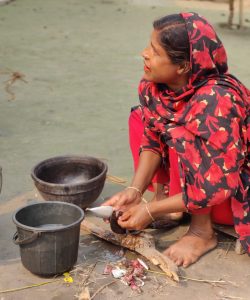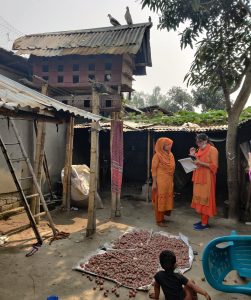Food is more than a basic need; what we eat is intrinsically linked to culture and many other factors, and diets have evolved over generations. Good nutrition is important, but supporting healthy diets in practice and at scale involves tackling challenges—cultural, economic, or practical—that often boil down to gender dynamics and other constraints facing families.
Over the past few decades, CGIAR researchers and others have generated a large body of evidence on gender in food systems, encompassing agriculture, value chains, and markets. Much less work has been done on gender and intrafamilial dynamics and how they affect what different people within families eat. Although CGIAR has a long record of research on intrahousehold food allocation, this work examined food allocation decisions made after food has been procured by the household. Links to the market and to agriculture were missing. On the nutrition side, CGIAR researchers evaluating numerous nutrition behavior change communication (BCC) programs have found that these programs have often tiptoed around how familial dynamics affect what is consumed. Some programs have explicitly engaged men based on an understanding of some, but not all, their roles around food. More recently, a pilot project in Bangladesh provided both agricultural training and nutrition BCC to husbands and wives together. Yet other interventions that rely mainly on women’s groups have not focused on engaging men at all. We think it is time to take a new look at familial dynamics around food, in particular in South Asia, where gendered societal norms favoring men collide with high burdens of malnutrition and poor diets across the population.
There is considerable research on the what of South Asian diets—what they consist of and their nutritional qualities. These  studies show that South Asians do not consume enough vegetables, fruits, or protein-rich foods (World Bank 2021). Some evidence suggests that the consumption of unhealthy foods, including ultra-processed foods, is on the rise. Studies on the affordability and accessibility of nutritious foods highlight that while nutritious diets may seem out of reach for most poor households, there are ways to make them affordable by shifting the focus of policies away from energy-dense staples toward nutrient-rich foods.
studies show that South Asians do not consume enough vegetables, fruits, or protein-rich foods (World Bank 2021). Some evidence suggests that the consumption of unhealthy foods, including ultra-processed foods, is on the rise. Studies on the affordability and accessibility of nutritious foods highlight that while nutritious diets may seem out of reach for most poor households, there are ways to make them affordable by shifting the focus of policies away from energy-dense staples toward nutrient-rich foods.
We know much less about the why, how, and who of food consumption in South Asia. “Why” deals with the factors that drive people to consume the food that they do. Access, availability, and affordability are important factors. But the choice between consuming potatoes or carrots, for example, also boils down to taste and preferences. Equally important are power dynamics among household members that dictate whose preferences matter most. Information and nutrition knowledge (or lack thereof) are also relevant but unlikely to be the most important driver. Much remains to be studied, therefore, on the drivers of dietary choice in a diverse and rapidly changing region such as South Asia.
The “how” relates to the everyday nuts and bolts of putting food onto plates across homes in South Asia. Procuring ingredients and preparing meals, including washing, cutting, cooking, waiting, serving, feeding, and clean-up are significant investments in the act of feeding families. And the difficulty of these tasks depends on the type of cooking equipment and fuel, and the number and frequency of meals. The numerous practical acts involved in getting food to family members are repeated across the day, and change over the course of a lifetime of parenting or caregiving. They are largely undertaken by women in South Asia, as they are in many parts of the world, but we know little about the extent or nature of other family members’ contributions.
 Finally, the “who” examines the people involved in both the why and how. Who decides why certain foods are consumed and who performs the tasks involved? Perhaps the (not so) naïve answer is that men make decisions, or express preferences, and women prepare the meals. In South Asia, women are known to do the bulk of household chores and caregiving. A study using nationally representative survey data from India examined multigenerational households to compare time spent by daughters-in-law, mothers-in-law, sons, and fathers-in-law on household work. It found that virtually all daughters-in-law and 81% of mothers-in-law participate in housework and the men do not participate at all. Moreover, daughters-in-law spend significantly more time doing housework than mothers-in-law. Evidence from Bangladesh also supports the hypothesis that patriarchal gender norms and agreement with such norms lead to greater work burdens for women. A study in Nepal found that that while the hours worked by daughters-in-law are only marginally more than those reported by mothers-in-law, the former have much less agency over their labor and less control over the outputs. There are also differences among sisters-in-law within the same household in rural India, their social status, and how it affects the health of their children. These differences are thus not only a gender issue but also an equity issue among female household members. However, few studies have examined the continuum of tasks across the food system—from production to market engagement to actions within the home that affect the preparation and consumption of food. We believe this is profoundly important to understanding how familial dynamics play out across the food system in a changing world.
Finally, the “who” examines the people involved in both the why and how. Who decides why certain foods are consumed and who performs the tasks involved? Perhaps the (not so) naïve answer is that men make decisions, or express preferences, and women prepare the meals. In South Asia, women are known to do the bulk of household chores and caregiving. A study using nationally representative survey data from India examined multigenerational households to compare time spent by daughters-in-law, mothers-in-law, sons, and fathers-in-law on household work. It found that virtually all daughters-in-law and 81% of mothers-in-law participate in housework and the men do not participate at all. Moreover, daughters-in-law spend significantly more time doing housework than mothers-in-law. Evidence from Bangladesh also supports the hypothesis that patriarchal gender norms and agreement with such norms lead to greater work burdens for women. A study in Nepal found that that while the hours worked by daughters-in-law are only marginally more than those reported by mothers-in-law, the former have much less agency over their labor and less control over the outputs. There are also differences among sisters-in-law within the same household in rural India, their social status, and how it affects the health of their children. These differences are thus not only a gender issue but also an equity issue among female household members. However, few studies have examined the continuum of tasks across the food system—from production to market engagement to actions within the home that affect the preparation and consumption of food. We believe this is profoundly important to understanding how familial dynamics play out across the food system in a changing world.
Why is it important to understand family dynamics across the food system ?
Understanding the why, how and who of food consumption is essential to develop feasible and sustainable solutions for healthy diets in South Asia. First, the disparities across class, caste, ethnicity, gender, and lifecycle stages illustrate the fundamental inequities that form barriers to good nutrition. Second, understanding the complexities underlying dietary choices is essential to formulating supportive policies and programs that can address the variety of issues that shape what families eat. Finally, without knowing the players in this process and their dynamics, it is impossible to design effective interventions or policies. We must first know what constraints exist, and how these constraints differ within the household for men and women, boys and girls.
Measurement is key to understanding how this process unfolds in diverse contexts. As with our work on understanding how women are empowered around decisions in agriculture and nutrition, we believe it is important to focus in on how women and men—of different ages in their families—navigate food system dynamics. We aim to develop data and evidence using diverse methods to bring to the conversations around gender and food systems, starting with work in South Asia. Stay tuned!
Neha Kumar, Agnes Quisumbing, and Purnima Menon are Senior Research Fellows in IFPRI’s Poverty, Health and Nutrition Division. Purnima Menon is also Senior Director, Food and Nutrition Policy, CGIAR.
All images are credited to Samuel Scott.

